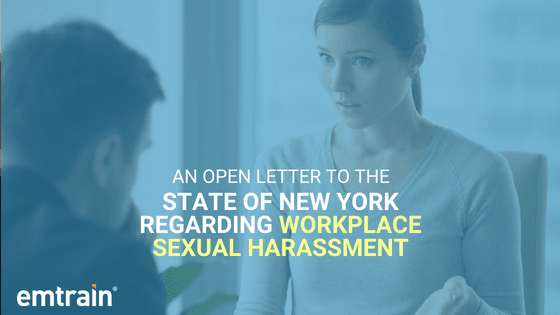Guidance on Workplace Sexual Harassment is a Good Start, but Current Content Will Have Unintended Consequences that Will Make it Harder to Accomplish Your Goal to Eradicate Workplace Sexual Harassment
In April of 2018, Gov. Cuomo signed a bill which included, among many other provisions, new rules on how to identify, prevent, and resolve issues of workplace sexual harassment.
The legislative mandates are the most sweeping of any state and New York is rightfully being lauded for its commitment to end workplace sexual harassment. The statute’s preamble, along with statements issued by the Governor and numerous sponsoring legislators, make the intent of this sweeping legislation clear: The law seeks to give voice to victims of harassment, hold individual perpetrators of harassment accountable, and send a strong message to employers about the prohibition of organizational tolerance and complicity.
Last week, the state issued guidance on how to comply with these new mandates. It’s a good start, but the authors of the guidance must ensure that the final language helps to achieve the law’s intended objectives. As currently written, some of the provisions have the potential to do the opposite.
This letter focuses on three documents – the sample policy, the sample complaint form and the guidance on training – and provides suggestions on how to improve them to make it more likely to assist employers and employees in their quest to end harassment.
Sample Policy
My guess is that the state will receive many comments about these and other issues related to the proposed policy language. Many of these comments will be from constituents with an agenda of advocacy—they will likely be “pro-employee” or “pro-employer.” By contrast, Emtrain is committed to providing resources and guidance that is equally applicable to leaders, managers and non-management employees. Our goal is to help everyone at work do their part to create and maintain a healthy, productive and inclusive workplace culture. And while the state’s commitment to prevent harassment is laudable and much of the guidance given is helpful, there are a few things included in the sample policy that miss the mark.
Definition of “sexual harassment”
The definition of this key concept, as written, leaves out a critical component of unlawful sexual harassment.
Under the section “What is ‘Sexual Harassment?” the language indicates: “A sexually harassing hostile work environment consists of words, signs, jokes, pranks, intimidation or physical violence which are of a sexual nature, or which are directed at an individual because of that individual’s sex. Sexual harassment also consists of any unwanted verbal or physical advances, sexually explicit derogatory statements or sexually discriminatory remarks…” Indicating that “any” unwanted conduct is sexual harassment ignores the long-recognized legal requirement that that behavior is considered unlawful only if it is severe or pervasive.
This misstatement of the law will cause confusion and hurt employers and employees alike. Employers will be required to give employees inaccurate legal information and will have to find other avenues to clarify the mistake.
Employees will mistakenly believe that even one incident can be a basis for a legal claim and might miss out on the opportunity to engage their company’s internal complaint mechanism.
Everybody wins if companies are encouraged (or required) to implement robust and authentic complaint investigation resolution systems that encourage reports of misconduct (I call it a culture of truth-telling) and that approaches complaints as an opportunity to problem solve, rather than a burden.
With the current definition, one unintended consequence will be that employees might bypass the chance to address issues early, thereby making it more likely that the behavior will escalate and become unlawful harassment. Further, it may cause employees to think they need to seek legal counsel before giving their company a chance to address their concerns.
Complaint and investigation process
There are a number of issues with this section, all of which have a significant chance to be counterproductive.
Investigation of all complaints (emphasis in original): This makes sense. The state of New York, like many other legislators and private citizens, knows that too many reports of sexually-charged or sexist behavior have been ignored. It’s this attitude—ignore complaints, especially if they’re against high-powered leaders—that ultimately culminated into the #MeToo movement.
However, those of us who have received workplace complaints and conducted investigations know that not every single complaint can or should be formally investigated.
What’s better than requiring a full-blown investigation every time an employee uses a legally-charged term? A few things.
First, develop an early resolution program. That means you teach employees to call out bad behavior as soon as it starts—whether you’re the target or a bystander. Sometimes employees won’t be comfortable intervening, but having that as an option is helpful for everyone.
Next, teach employees a new language—one that doesn’t focus exclusively on legal terminology. Rather than “he harassed me,” teach employees to describe the behavior and its effect. “Rob calls me ‘honey’ in meetings. It’s embarrassing and demeaning and gives me the impression he doesn’t respect me as much as my male colleagues. I’d like your help so he can see how damaging his words are and stop talking to me this way.”
Finally, provide workplace investigators with the proper tools and resources to learn how to distinguish reports of misconduct that warrant an investigation and those that involve uncomplicated employee relations concerns. And make sure that organizations give these investigators the authority to conduct investigations and implement remedial measures that actually fix problems, rather than conducting perfunctory and inauthentic inquiries that everyone knows will lead to a slap on the wrist at most.
Use of complaint form: While it’s understandable that the state wants to encourage employers to keep verifiable records of harassment complaints, the form itself (see below) and the language about its use misses the mark. The policy “encourages” complainants to use the form. That’s good—the policy doesn’t mandate its use. However, the section goes on, “If [the complainant] refuses, prepare a Complaint Form based on oral reporting.” It’s semantics, but labeling an employee declining the “encouragement” to fill out a form shouldn’t be characterized as a refusal. Employees reading that type of language might mistakenly interpret it as intimidating and feel discouraged (rather than “encouraged”) from making a report in the first place.
Procedure: The policy says investigations should be completed in 30 days. This timeline is likely reasonable for a large percentage of investigations, but adding in language giving investigators the ability to use his/her judgment would be helpful. Similarly, the policy currently says “all parties involved, including relevant witnesses” will be interviewed. In many (most) investigations, there is no need to speak to every single person who might have information about the complaint. In fact, in many instances an investigator is able to thoroughly collect information without speaking to everyone and would cause greater harm by further expanding the inquiry.
In both these examples, the state appears to want to standardize workplace investigations—to provide guardrails to prevent incomplete or sham investigations. This is a great goal. However, what is missing is that workplace investigations, by definition, are not cookie-cutter endeavors. They require tons of judgment, compassion and customization. Having these types of requirements and taking away an investigator’s need to use independent and unbiased judgment will do more harm than good.
Investigation reports: The policy calls for a very structured written investigation report that includes (apparently) mandatory sections: a list of document reviewed and a summary of the documents; a list of witnesses and summaries of what they said; a timeline of events; a summary of prior relevant incidents (reported and unreported); and the final resolution of the complaint (along with the corrective action taken).
First, this again undercuts the autonomy that must be given to impartial workplace investigators. I know, the intent here is to recognize that too many so-called “impartial investigators” were anything but. That’s fair and something needs to be done to make sure investigations are timely, provide everyone due process, are fair and are conducted by fair-minded professionals who seek to find the truth, solve problems and make the workplace better. This policy doesn’t do that. Instead, it seeks to build in impartiality through a strict structure, but this won’t remove bias, it will simply take away control and judgment.
Additionally, if investigators have to produce this type of report for every single investigation they conduct (particularly if they have to investigate and produce this type of report every time an employee lodges a complaint, as discussed above), employers will be required to hire an army or workplace investigators to handle the workload and the department will lose its independence and objectivity and will instead worry about finishing investigations quickly and hastily churn out reports.
Written documentation of investigation: The policy indicates the employer should “keep written documentation and associated documents in the employer’s records.” This is a good practice, but the language should include a clarification—these documents should be kept in a separate investigation file, NOT in personnel files. (The only document that should be in the personnel file is any written discipline or summary of discipline in the file of the person found to have engaged in misconduct.) Without this caveat, employers might place information about an investigation in a complainant’s personnel file, which could wreak havoc.
Information to complainant: “Inform the individual who complained of their right to file a complaint or charge externally as outlined below.” Any individual has the right to file a complaint and therefore there is technically nothing wrong with this mandate. The problem is that not all workplace complaints rise to the level of illegality and therefore may be dismissed by outside entities. Investigation reports should not reach legal conclusions, only factual conclusions (“Sue’s claim that Bob sent her ten sexually-charged emails is substantiated…” NOT “Sue’s claim that Bob sexually harassed her is substantiated…”) and the implication of this clause is that every employee has a case that will lead to employer liability. Additionally, this puts the workplace investigator in the uncomfortable position to have to field further questions about whether the complainant should move forward with a legal claim.
In the policy author’s quest to make sure all complaints are taken seriously and to provide a structure for conducting impartial investigations, they have overstepped and instead have taken away a crucial element of the investigation process: allowing investigators to use their sound judgment when looking into workplace concerns. If the language in the policy stems from an inherent mistrust of the system or a belief that internal investigators are fundamentally biased, my recommendation is to draft a comprehensive guide on how to conduct impartial investigations like we did in California.
Sample Complaint Form
I see two fundamental issues with the sample complaint form.
Asking complainant for legal information: Question #2 states,“Please describe the conduct or incident(s) that is the basis of this complaint and your reasons for concluding that the conduct is sexual harassment.” A better question would be to ask the complainant to describe the conduct that is unwelcome and/or offensive in detail and ask that person to describe the effect the behavior has on his/her ability to conduct their work as efficiently as possible (or words to that effect). Asking the complainant to not only provide information but to essentially reach a legal conclusion is dangerous and counterproductive. It also might discourage an employee from using this form since coming up with reasons “why this is harassment” is daunting.
Chilling effect: The form indicates that Questions #5 and #6 are “optional, but may help facilitate the investigation.”
Question 5 seeks information about whether the complainant has “previously complained or provided information about sexual harassment.” To the extent this is asking for the complainant’s involvement in prior investigations, the employer is actually in a much better position to research that issue and find any relevant documentation, so putting that burden on the complainant seems misplaced.
And to the extent this question seeks information about whether the conduct has been previously reported to another manager or supervisor, that’s an issue that should be explored during a formal interview (during which the complainant should be given an opportunity to not only share details about the concern, but also share any relevant documents).
Question 6 has three parts that seek information about whether the complainant has filed a complaint with an enforcement agency, with a court, or whether the complainant is represented by counsel. It’s unclear the intent behind these questions, and while they are labelled as “optional,” there is a high likelihood that their mere presence will have a devastating and counterproductive chilling effect. After all, a complainant is presumably trying to engage the company’s internal complaint-resolution mechanism in an effort to report concerns that, if substantiated, should be fixed at the workplace level.
Training Guidelines
The training guidelines include the same definitions contained in the sample policy, so the comments above related to how to improve that language apply equally to the guidance on training and the improved language should be transferred to the training script as well.
The content is otherwise helpful, but there is one area that requires clarification and that’s with the definition of “interactivity” (since the legislation requires that training be interactive).
The guidance provides four examples of how training might be deemed interactive and says that “the training should include as many of [them] as possible. The four are:
- Be web-based, with questions asked of employees as part of the program
- Accommodate questions asked by employees
- Include a live trainer made available during the session to answer questions
- Require feedback from employees about the training and the materials presented
It’s unclear which of the suggestions apply to live versus online training.
One recommendation is to review and adopt the requirements in the corresponding California regulations. Those regulations state that since the legislative intent was to have interaction the answer when it comes to e-learning is to replicate that interactivity as much as possible. To that end, the California regulations require that the subject matter experts who developed the online training courses must be available to answer learner questions, and that those questions need to be answered in two business days.
While the intentions behind the new New York State guidance are good, the guidance, unless revised, has a significant potential of undermining the legislative intent. We need to ensure that these mandates are enforced in a manner that encourages dialogue in the workplace and seeks to empower employees to raise concerns. If we encourage New York employers to adopt the templates that have been currently provided, we may be taking two steps back in our approach to sexual harassment prevention and training.
After forty years of talking about sexual harassment in the workplace, it’s time we give employers the tools they need to make progress in this area.








